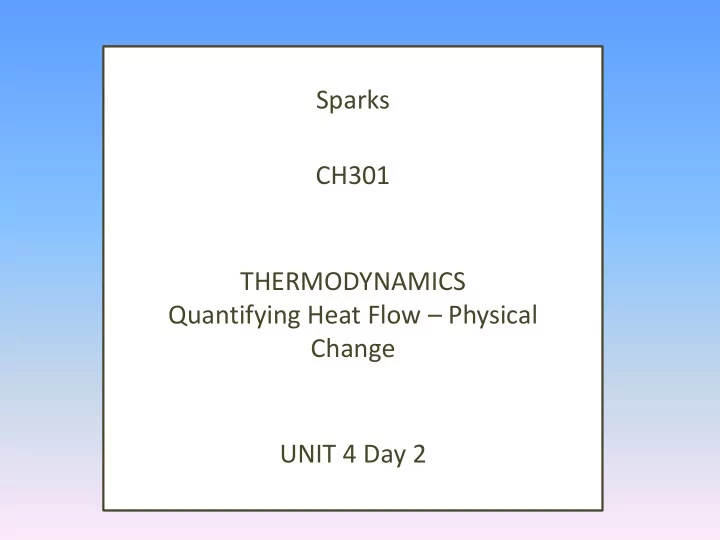

Sparks CH301 THERMODYNAMICS Quantifying Heat Flow – Physical Change UNIT 4 Day 2
• You can burn 55,000 calories by drinking 6 glasses of ice water.
What are we going to learn today? State Functions Review q, w, Δ U Quantify Change in Energy by Quantifying Heat
State Functions • A property of the system whose value depends ONLY on the current state of system, NOT how it got to that state. • Symbols for state functions always written in CAPITAL letters.
State Functions A property with a value that depends only on the current state of the system and is independent of the pathway. If the system is changed from one state to another, the change in a state function is independent of how that change was brought about! (E is a state function, w and q are not state functions!) Δ X = X f - X i
When I think of types of energy, I think: WHAT IT IS: PE - energy due to position or composition KE - energy of the motion of an object or particle HOW IT MOVES: Heat - transfer of energy from a hotter body to a colder body Work – transfer of energy via applied force over distance
Gummy Bear Demonstration Kilocalorie (Calorie) – nutritional unit calorie – the amount of energy it takes to raise the temperature of 1 gram of water 1 degree C. 1 cal = 4.184 J
POLL: iCLICKER QUESTION In the gummy bear demonstration, q for the system is: A. Positive B. Negative
Let’s think about work Methanol cannon demo: CH 3 OH (g) + 1.5 O 2 (g) CO 2 (g) + 2 H 2 O (g) Physical or chemical change? What is happening to the total moles of gas? What will this mean to the total volume? Will work have a positive or negative value?
• Consider these reactions, with constant T and P: 2 NO (g) + O 2(g) 2 NO 2(g) NaHCO 3 (s) + CH 3 COOH (l) NaC 2 H 3 O 2 (aq)+ CO 2 (g) + H 2 O(l)
First Law of Thermodynamics – LAW OF CONSERVATION OF ENERGY UNIVERSE = SYSTEM + SURROUNDINGS YOU DEFINE YOUR SYSTEM, EVERYTHING ELSE IS SURROUNDINGS ΔU = q + w
CONCEPTUALIZE ENERGY ON THE MOVE THINK ABOUT A POWER PLANT FUEL WATER STEAM TURBINE GENERATOR How much energy does it take to boil enough water to generate enough steam to continue to make enough steam to generate enough electricity for the UT campus? REACTANTs PRODUCTS ΔU = ?
MODEL & QUANTIFY HEAT HEAT = q 1 calorie = quantity of heat needed to raise the temperature of 1 gram of water 1 ° C. 1 Joule = Applying a 1 N force over a distance of 1 m Joule is famous because he found the relationship between heat and energy. He found by dropping weights, moving a paddle and noting the increase in temperature of water that 1 cal = 4.164 J. Measure changes in T of water and correlate that to energy in or out of a system!
CONCEPTUALIZE ENERGY ON THE MOVE LARGE BEAKER OF WATER ON HOT PLATE SMALL BEAKER OF WATER ON HOT PLATE Thermal Energy = Kinetic Energy of the Particles (which has to do with the T) Heat Capacity = heat absorbed increase in temperature
CONCEPTUALIZE ENERGY ON THE MOVE Thermal Energy = Kinetic Energy of the Particles (which has to do with the T) Heat Capacity = heat absorbed increase in temperature Which beaker had the higher Thermal Energy? a) LARGE b) SMALL Which beaker had the higher Heat Capacity? a) LARGE b) SMALL
QUANTIFY ENERGY ON THE MOVE Measure the heat transferred into or out of a system using heat capacity, C. C x Δ T = q Specific heat capacity Molar heat capacity
Learning Outcomes Calculate change in enthalpy for physical change in T and Phase Change Understand the concept of heat capacity, specific heat capacity and molar heat capacity
Important Information LM28 and HW Posted.
Recommend
More recommend